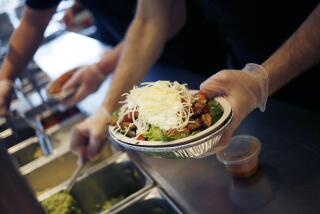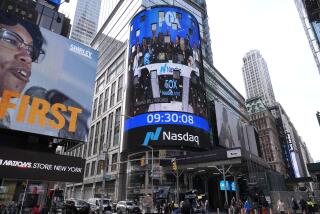Blue Apron stock edges up from the IPO price that fell far short of expectations

With Blue Apron’s initial public offering in full swing, the meal delivery start-up is finding out there is some appetite for its stock — but investors aren’t slavering for it.
The 5-year-old company, which sends customers a weekly box of recipes and accompanying ingredients, saw its shares rise 3.5% Thursday to $10.35 in the hours after its debut on the New York Stock Exchange.
But Blue Apron Holdings Inc. faces an increasingly competitive market: Besides other cook-it-yourself start-ups, there also are meal delivery kits that involve only microwaving and an explosion of restaurant delivery apps; huge companies such as Amazon.com also are eyeing the space.
In a troubling sign, Blue Apron slashed its IPO price Wednesday to $10 a share, significantly lower than its original estimate of $15 to $17 a share. Blue Apron raised $300 million with the offering, selling 30 million shares of Class A stock at the $10 price — well below the amount it had hoped to raise.
The sharply lower price indicated that investors have heightened concerns about how Blue Apron, which reported nearly $800 million in revenue last year but is unprofitable, will fare in the fast-changing market for food shopping.
“The competition for stomach share is fierce,” said Aaron Turner, an analyst at Wedbush Securities. “The onus on Blue Apron after they go public is to maintain their user growth, but to do so in a cost-efficient manner. And sometimes that can prove challenging.”
Blue Apron also has to contend with fickle customers, many of them millennials.
Joshua Lawton-Belous first tried Blue Apron two years ago when he and his wife wanted to save time on grocery shopping.
“It was delicious,” he said. Blue Apron’s meals also allowed them to try new dishes, and “I loved the idea that I didn’t need to go out and buy huge amounts of spices for one meal,” said Lawton-Belous, 33, who lives in Austin, Texas.
But after five months, the couple stopped ordering. “I don’t want to spend 50 minutes cooking anymore when I could just go to a restaurant or go to Whole Foods,” he said.
Whole Foods might become an even more appealing choice for shoppers now that online giant Amazon.com has agreed to buy the upscale grocery chain for $13.7 billion.
With consumers already pressing for healthier foods and more convenient service, there’s widespread speculation that Amazon will use Whole Foods as a springboard for expanding its grocery delivery efforts and altering the food-shopping landscape overall — at an affordable price.
Customer retention is one of the biggest challenges for Blue Apron. More than half of meal-kit subscribers in general cancel their subscriptions within the first six months, CNBC reported last month, citing data from the purchase-analytics firm Cardlytics.
Even so, “it would be a mistake for investors to dismiss meal-kit delivery services” in part because their customers “are often some of the most lucrative and influential customers for traditional grocers, specialty grocers and restaurants,” the research firm Morningstar said in an April report.
That’s also why Morningstar said that after Blue Apron’s IPO, it expects “grocers to target a number of other leading meal-kit services as acquisitions.”
Blue Apron sold 30 million shares of Class A stock under the ticker symbol APRN. The initial share price gave the company an overall market value of about $1.87 billion.
The company also has Class B stock with super-voting rights held by the company’s founders, management and major investors, who together still control about 98% of the voting power at Blue Apron, according to the company’s stock-registration filing.

They include its chief executive, 33-year-old Matthew Salzberg, a former venture capitalist who holds nearly 30% of the voting power. The company was founded by Salzberg, Chief Operating Officer Matthew Wadiak and chief technology officer Ilia Papas.
In its filing, Blue Apron said it averaged 1.04 million customers in the quarter that ended March 31, up from 213,000 two years earlier.
The customers’ average order totaled $57.23 in the quarter, slightly below the $57.77 average as of March 2015.
Blue Apron’s revenue totaled $795.4 million last year, up from $77.8 million in 2014, but it also lost a combined $132.7 million over those three years, including a $54.9-million loss last year.
One reason for the losses is that Blue Apron’s spending on marketing soared in that period, to $144 million last year.
The heavy marketing spending, along with Blue Apron’s promotional discounts for new subscriptions, is needed partly to attract enough new customers to offset cancellations.
But those who stick with the program appear to like it; Blue Apron said 92% of its first-quarter revenue this year was generated from repeat orders.
“Everything comes to me pre-measured, and I love that,” said Celeste Sales, 48, a human resources director in Truckee, Calif., and a Blue Apron customer for two years. Sales said she now goes to the grocery store only about once every three weeks.
Blue Apron provides original recipes that customers choose either on the company’s website or mobile app.
Its offerings Wednesday included a bulgogi beef and soba noodle stir-fry with marinated vegetables, a seared chicken and pasta salad and a fresh basil fettuccine. The firm also sells a variety of wines.
“While you do have to do work — you do have to prepare, you do have to clean — they’re saving you time in the store and they’re saving you stress of what to make for dinner,” said Darren Seifer, a food and beverage analyst at the research firm NPD Group.
But the meal kits’ relatively high prices also are one reason consumers are leaving these services, he said.
“To prove their value and prove that it’s worth the price, these companies are going to have to step up their game,” Seifer said.
Blue Apron has nothing to prove to Pamela Castellana of Melbourne, Fla., who said she received a free month of Blue Apron as a birthday gift from her daughter about 18 months ago and was instantly hooked.
“The food that comes is so fresh and so good,” said the Mary Kay Cosmetics sales director. “It’s just the right amount of food.”
Castellana, 55, also praised Blue Apron’s customer service, saying the firm has always responded to emails within an hour about missing ingredients or food that wasn’t extremely fresh, and given her $10 worth of credit.
One time, when her box was mistakenly delivered three doors away, Blue Apron gave her a full week’s worth of credit.
Castellana said that, for her and her husband, “we’re lifers.”
Twitter: @PeltzLATimes
ALSO
Fox’s pursuit of European pay-TV giant Sky hits a new roadblock
AMC is giving Comcast subscribers the option to watch ‘The Walking Dead’ ad-free — for a price
Walgreens ends years-long attempt to buy Rite Aid
UPDATES:
9:35 a.m.: This article was updated with Blue Apron shares’ early trading information.
This article was originally published at 6:55 a.m.








